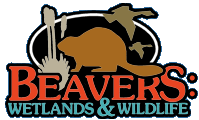WHY NOT COEXIST?

Some people think the solution to any conflict with beavers is to remove them, but this is rarely a lasting solution, and may even create more serious problems.
Liability is a major concern because the Conibear traps, commonly used for beavers, can also injure people and kill rare species, such as Bald Eagles, and pet dogs. In the worst cases, a family has had to watch while their pet slowly dies – this trap is almost impossible for an untrained person to open – and a hefty lawsuit has resulted.
Removal is rarely a lasting solution as other beavers in the area tend to resettle the empty habitat within a year or two. In the meantime, if a dam was destroyed or disintegrates without upkeep, a valuable pond with many dependent species may be lost. Seeing a vibrant wetland turn into a mudhole with many dead fish and other creatures is upsetting. If the pond was important for the survival of a threatened or endangered species, there may be legal action, such as the $4 million claims against the city of Birmingham.
BEAVER KITS
Because beaver kits stay with their parents for two years to learn survival skills, trapping “nuisance” adults often leave helpless kits behind. Nursing kits may swim up to a human, and if taken to a wildlife rehabilitator, that person may need to spend two years caring for the orphans before they can be safely released.
A simple, easy way to deal with beavers on your land, or in your neighborhood, is learning to live with them. (If there is a problem, go to the other pages in this section for solutions.) Try taking a walk to their pond an hour or two before sunset, to relax and enjoy the variety of birds and wild animals. If the area is posted to protect the wildlife, consider leaving some cracked corn at the shoreline to attract birds and/or throwing a few apple halves in the water for the beavers. Don’t try to hide behind a bush or tree, as the beavers will know you’re there, but do stay about 15 feet from the shore and talk rather quietly.
At first, you may only see – and hear – some loud tail slaps, but if pond sitting becomes a habit, the wild residents will begin to accept you. Watching the beavers and their interactions with other animals is fun and educational for children, and can become an absorbing, lifelong hobby for adults. If you spend enough time at a beaver pond, eventually you will meet almost all of your wild neighbors. By learning to coexist you are not only solving your own problem, but helping to save our land’s best ecosystem and that provides great benefits for your neighbors downstream.
About Kits

OTHER RESOURCES
Beaver Institute – Trains BeaverCorps installers and does much more.
Humane Society of the United States – the largest nation’s animal protection organization often helps with beaver problems. The main HSUS office is in D.C., plus there are regional’s offices.
Partners for Fish and Wildlife – a program of the U.S. Fish and Wildlife Service that may provide materials for a beaver water level control device when an organized entity can maintain the device. Contact your regional FWS office to learn more.
Beaver Defenders – based at Unexpected Wildlife Sanctuary in New Jersey. Visits to Unexpected Refuge are by appointment (manager@unexpectedwildlife.org), and does beaver education and can help with beaver conflicts.
Born Free USA – a nonprofit that has sponsored beaver installations and helped with beaver issues in Canada and the U.S.
The Fur-Bearers – a Canadian nonprofit that often helps with beaver issues and cases.
Lands Council – an environmental nonprofit that is reintroducing beavers into Eastern Washington to improve the ecology.
The WATER Institute – of the Occidental Arts and Ecology Center in California.
Worth a Dam – a group that saved an urban California beaver family, and continues to promote the species via an annual festival and at their website.
Also, see Beaver Consultants by going to the “Solving Problems” drop-down menu, clicking on “Manage Flooding” and scrolling down.
